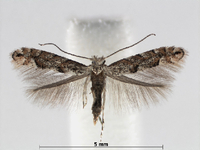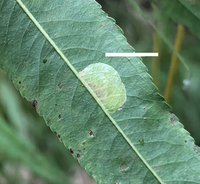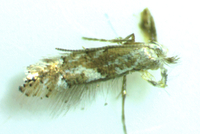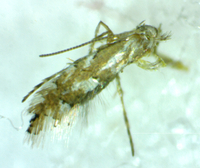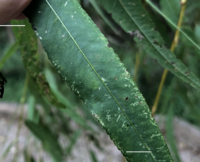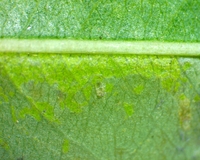Identification
Field Guide Descriptions: Online Resources: MPG , BugGuide , iNaturalist , Google , BAMONA , GBIF , BOLD Technical Description, Adults: Davis and Deschka (2001)Technical Description, Immature Stages: Davis and Deschka (2001)
Adult Markings: Davis and Deschka (2001) provided a comprehensive review of the Salix-feeding Phyllonorycter species and noted that this wide-ranging species exhibits the greatest amount of morphological variation of any North American Phyllonorycter . Variation occurs in both external features and the genitalia and has caused much confusion among workers. As an example, adults that were mostly reared and previously identified as P. salicifoliella by a highly respected and knowledgeable worker on the Gracillariidae contained representatives of five species of Phyllonorycter . Most of the confusion reflects variation in the forewing pattern and male genitalia. The genitalia tend to show normal within-population uniformity but also exhibit conspicuous between-population differences that in some cases may occur between adjacent populations. Genitalia and DNA bar-coding probably provide the most reliable way to identify specimens. The following description is based on Davis and Deschka (2001).
Forewing Length: 3-4 mm (Davis and Deschka, 2001)
Adult Structural Features: Davis and Deschka (2001) has detailed descriptions and illustrations of the male and female genitalia.
Immatures and Development: Females attach their flat eggs to the lower leaf surface. A given female normally lays one egg per leaf, but a leaf can have several mines that are the product of two or more females. The first three instars are sap feeders, while the last two switch to consuming parenchyma tissue. The first instar produce a slender, serpentine to wedge-shaped, subepidermal tract on the underside of the leaf that is enlarged by the next two instars to form an oval blotch (Davis and Deschka, 2001). The later instars typically do not enlarge the area of the mine, but simply feed deeper into the leaf tissue. Silk that is spun across the mine causes the mine to pull together to form a tentiform structure with a single longitudinal fold (rarely two or three folds may be evident). The granular frass is collected at one end of the mine and pupation occurs within the mine in a silken cocoon that is often located near the center.

 »
»